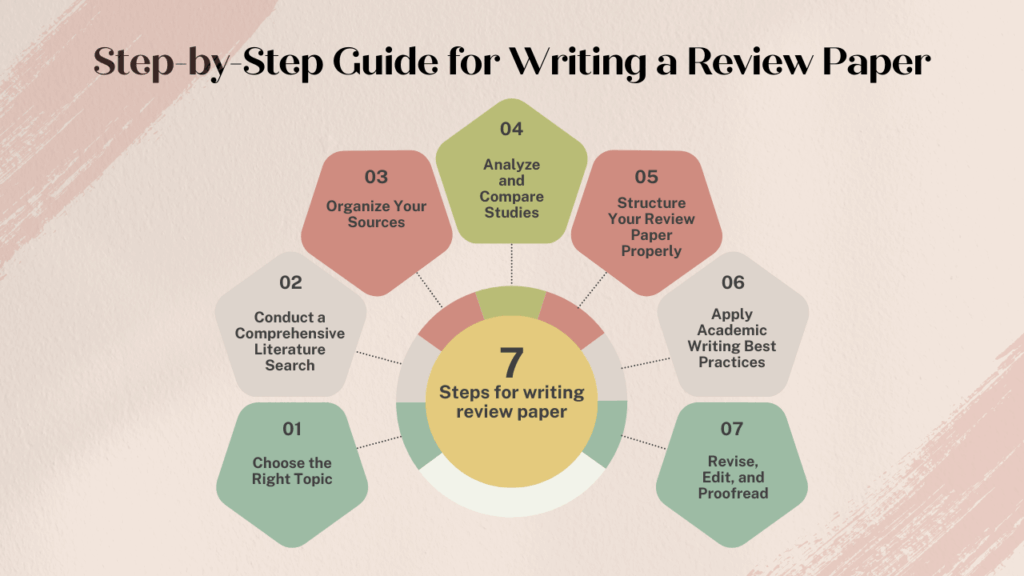How to Write a Review Paper? A Complete Guide for Beginners
Kenfra Research - Bavithra2025-08-22T11:40:16+05:30Writing a review paper is one of the most important skills for students, researchers, and academics. A review paper is more than just summarizing research; it involves critically evaluating and synthesizing existing studies to provide a comprehensive overview of a topic. Learning how to write a review paper helps you develop academic writing skills and contributes to scholarly discussions in your field.
In this guide, we will walk you through a step-by-step process to write a review paper, explain the best structure to follow, and provide practical tips to make your work stand out. Whether you are writing for a thesis, dissertation, or journal submission, this guide has you covered.
What Is a Review Paper?
A review paper is a scholarly article that summarizes, organizes, and interprets existing research on a particular topic. Unlike a research paper that shares new findings, a review paper focuses on summarizing and analyzing existing research on a topic:
- Analyzing trends in previous studies
- Highlighting gaps in the current knowledge
- Providing a critical perspective on the research field
Writing a review paper requires not only gathering sources but also synthesizing information in a way that is clear, organized, and valuable for other researchers. It is a fundamental part of scholarly writing and academic publishing.
Step-by-Step Guide: How to Write a Review Paper

Here’s a detailed, actionable guide to writing a review paper from scratch.
1. Choose the Right Topic
Selecting a suitable topic is crucial. The topic should be:
- Focused – avoid overly broad topics that are difficult to cover comprehensively.
- Relevant – it should align with your field of study or research interest.
- Supported by sufficient literature – ensure there is enough research to review.
For instance, instead of choosing “Artificial Intelligence,” a more focused topic would be “Applications of Artificial Intelligence in Healthcare.” This makes your review structured, meaningful, and easier to organize.
2. Conduct a Comprehensive Literature Search
Once the topic is defined, gather all relevant studies using trusted academic databases such as:
- Google Scholar
- Scopus
- Web of Science
While reviewing the literature, take note of:
- Key findings from each study
- Publication year and trends
- Research methodologies used
3. Organize Your Sources
Organizing your sources is critical for a coherent review. There are several ways to structure your sources:
- Thematically: Group studies based on key themes or topics
- Methodologically: Organize research based on the methods used
- Chronologically: Present research developments over time
A well-organized approach ensures that your review paper flows logically, making it easier for readers to understand the topic.
4. Analyze and Compare Studies
A review paper is not just a collection of summaries. To write a strong paper, you must analyze and compare studies critically:
- Identify similarities and contradictions across studies
- Discuss the strengths and limitations of previous research
- Highlight gaps or unexplored areas for future study
This analytical perspective sets your review apart from a simple literature summary and demonstrates your expertise in the field.
5. Structure Your Review Paper Properly
A well-structured review paper format is essential. Here’s the recommended structure:
Title
Your title should be short, clear, and include important keywords. For example:
“Recent Advances in AI-Based Medical Diagnosis: A Review”
Abstract
Write a 150–250 word summary that highlights the purpose, scope, and key findings of your review.
Introduction
Introduce your topic, explain its significance, and state the purpose of your review. Make sure to include your primary keyword how to write a review paper in this section.
Body
This is the core of your paper. Divide it into sections using themes, methodologies, or chronology. Each section should critically analyze the studies, not just summarize them.
Conclusion
Summarize the main findings and provide insights for future research. Highlight the gaps you identified during your review.
References
Include all sources cited in your paper. Follow the appropriate citation style required by your target journal (APA, MLA, etc.).
6. Apply Academic Writing Best Practices
Strong academic writing ensures clarity, professionalism, and credibility. Keep these tips in mind:
- Use formal and precise language
- Avoid personal opinions unless supported by literature
- Ensure proper citations to avoid plagiarism
- Use transition phrases for smooth flow between sections
Following these practices enhances readability and makes your review paper suitable for academic publishing.
7. Revise, Edit, and Proofread
Revision is key to producing a polished review paper. Focus on:
- Grammar and spelling
- Logical flow and coherence
- Accuracy of references
- Adherence to the chosen journal’s formatting requirements
Using tools like Grammarly or Hemingway can help identify errors and improve clarity.

Tips for Writing a High-Quality Review Paper
- Be selective: Include only credible, relevant studies
- Maintain balance: Represent different perspectives fairly
- Use visuals: Tables, figures, and charts help summarize data effectively
- Follow journal standards: Check formatting and submission guidelines carefully
By following these tips, your review paper will be structured, comprehensive, and impactful.
Final Thoughts
Learning how to write a review paper is an essential skill for every researcher. A well-written review not only demonstrates your ability to synthesize knowledge but also contributes to the academic community. By following the step-by-step guide, maintaining strong academic writing standards, and applying proper structure, you can create a review paper that is publication-ready and highly valued by your peers.







Leave a Reply